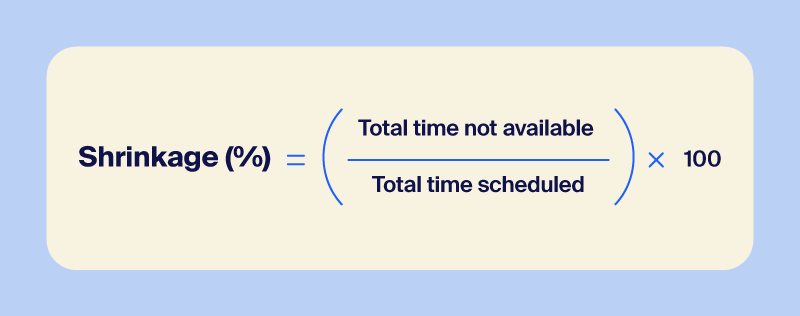
Meet Zoom AI Companion, your new AI assistant!
Boost productivity and team collaboration with Zoom AI Companion, available at no additional cost with eligible paid Zoom plans.
Call center shrinkage is the percentage of scheduled time agents are unavailable for customer interactions due to breaks, training, or other factors.
Updated on September 20, 2024
Published on September 20, 2024


Call center shrinkage is a crucial metric that often flies under the radar but significantly impacts a call center’s efficiency. Shrinkage refers to the percentage of time agents are unavailable to handle customer interactions even though they are scheduled to work. This can be due to a variety of reasons — breaks, training sessions, system issues, or unscheduled absences.
Imagine a scenario where a team of 50 agents is scheduled to handle customer calls, but only 40 are available due to various shrinkage factors. The result? Longer wait times, frustrated customers, and increased pressure on the available agents. Managing shrinkage effectively is vital for maintaining optimal call center performance, ensuring customer satisfaction, and keeping operational costs in check.
In this post, we’ll learn various causes of call center shrinkage, how to calculate shrinkage, and what you can do to reduce it.
Call center shrinkage is the gap between the number of agents scheduled to work and those actually available to handle customer interactions. It’s caused by internal factors like breaks, training, and meetings, as well as external factors such as system downtime or unplanned absences.
This reduction in available agents can lead to inefficiencies, where fewer calls are handled, increasing wait times and customer dissatisfaction. High shrinkage also strains agents, leading to burnout, and increases operational costs due to the need for overtime or additional staffing. Over time, unchecked shrinkage can damage a company’s reputation and erode customer trust.
Call center shrinkage is influenced by both internal and external factors that reduce available agent time. Internal causes stem from the everyday operations and management of the call center, while external causes are often beyond immediate control.

Internal factors of shrinkage are rooted in a call center’s daily activities and routines. These can include:
External factors contributing to call center shrinkage are often outside the organization’s direct control but still significantly impact performance. These factors include:
Understanding how to calculate call center shrinkage is essential for effective workforce management. The formula for calculating shrinkage is:
Shrinkage (%) = (Total time not available / Total time scheduled) × 100
This formula takes into account the total time agents are not available to handle calls divided by the total time they were scheduled to work. By multiplying this ratio by 100, you get the shrinkage percentage, which indicates how much of your scheduled workforce is not actively engaging with customers. The lower the shrinkage percentage, the more efficient your call center generally utilizes its workforce.

Reducing call center shrinkage requires a proactive approach to managing both internal and external factors. By leveraging the right tools and strategies, call centers can minimize shrinkage, improve efficiency, and enhance overall service quality.
Workforce management software is a powerful tool that can enhance agent scheduling, helping to ensure the right number of agents are available at all times. By accurately forecasting call volumes and automating shift assignments, this software can minimize gaps in coverage and reduce unnecessary downtime.
Real-time adherence monitoring within the software also allows managers to track agents’ activities against their schedules, identifying deviations and addressing them promptly. This way, agents stay on task, further reducing shrinkage and enhancing operational efficiency.
By consolidating training sessions and scheduling them during low-demand periods, agents are available when customer demand is highest. Additionally, automating routine administrative tasks, such as data entry or reporting, frees up agents’ time, allowing them to focus more on customer interactions.
Implementing microlearning sessions that fit into agents’ daily routines allows them to complete training in shorter, manageable increments without disrupting call flow.
Reducing call volume is a strategic way to minimize shrinkage by decreasing the demand on your agents. Implementing intelligent call routing directs customer calls to the most appropriate agent or department, reducing unnecessary transfers and handling times.
Additionally, enhancing self-service options, such as interactive voice response (IVR) systems and online FAQs, empowers customers to resolve common issues without speaking to an agent.
Health and wellness programs, such as stress management workshops or gym memberships, can help reduce absenteeism and improve overall agent well-being. Encouraging leadership to foster a culture of engagement and recognition also plays a key role in keeping agents motivated and committed.
Offer flexible work schedules to accommodate employees’ personal needs, enhancing work-life balance and reducing burnout.
Integrating AI into your contact center can help significantly reduce shrinkage by automating routine tasks and enhancing operational efficiency. AI-powered tools, such as chatbots and virtual assistants, can handle a large volume of customer inquiries, freeing up human agents to focus on more complex issues. This reduces the need for agents to be constantly available, lowering the overall shrinkage rate.
Additionally, AI can assist in predictive scheduling by analyzing patterns in call volumes and agent performance, helping managers improve workforce allocation and reduce idle time.
Real-time monitoring and analytics enable managers to quickly identify and address deviations from schedules, helping to ensure agents remain on task.
Call center shrinkage measures the portion of scheduled time agents are unavailable to take calls, such as during breaks or training. For example, if an agent is scheduled for an eight-hour shift but spends two hours in training, this two-hour period contributes to shrinkage, showing the time lost due to non-call activities.
Agent utilization, on the other hand, assesses how effectively agents use their available time to handle calls. For instance, if an agent is available for six hours after accounting for breaks and training but spends only four hours actively on calls, this indicates a two-hour gap in productive time.
A well-designed contact center is crucial for operational efficiency and minimizing shrinkage. Zoom Contact Center offers robust workforce management and quality management solutions tailored to achieve these goals. Advanced scheduling capabilities help improve agent allocation, while real-time adherence monitoring helps managers track and adjust agent availability on the fly.
The software also automates administrative tasks, reducing the time agents spend on non-customer activities and features intelligent call routing so calls can be directed to the right agents.
Request a demo for Zoom Contact Center today to see how we can help you streamline operations and ultimately reduce call center shrinkage.